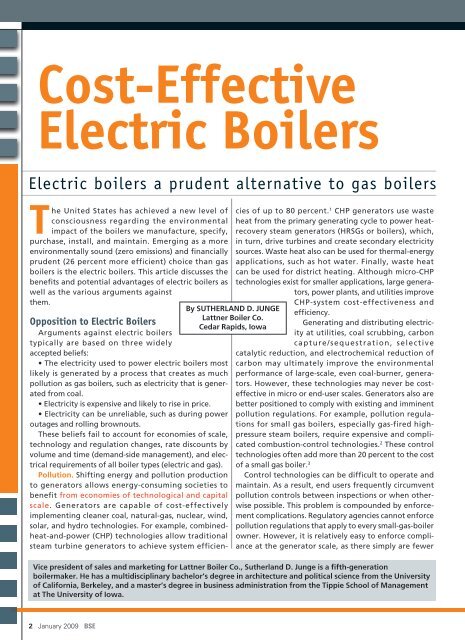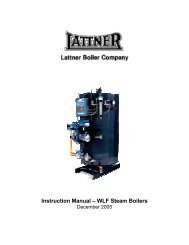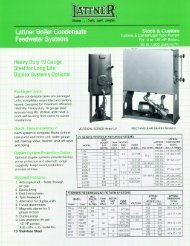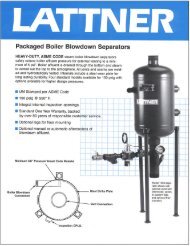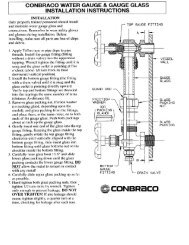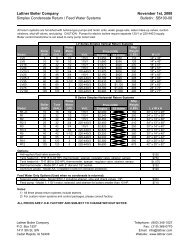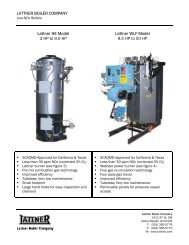Cost-Effective Electric Boilers - Lattner Boiler Company
Cost-Effective Electric Boilers - Lattner Boiler Company
Cost-Effective Electric Boilers - Lattner Boiler Company
Create successful ePaper yourself
Turn your PDF publications into a flip-book with our unique Google optimized e-Paper software.
<strong>Cost</strong>-<strong>Effective</strong><br />
<strong>Electric</strong> <strong><strong>Boiler</strong>s</strong><br />
<strong>Electric</strong> boilers a prudent alternative to gas boilers<br />
The United States has achieved a new level of<br />
consciousness regarding the environmental<br />
impact of the boilers we manufacture, specify,<br />
purchase, install, and maintain. Emerging as a more<br />
environmentally sound (zero emissions) and financially<br />
prudent (26 percent more efficient) choice than gas<br />
boilers is the electric boilers. This article discusses the<br />
benefits and potential advantages of electric boilers as<br />
well as the various arguments against<br />
them.<br />
Opposition to <strong>Electric</strong> <strong><strong>Boiler</strong>s</strong><br />
Arguments against electric boilers<br />
typically are based on three widely<br />
accepted beliefs:<br />
• The electricity used to power electric boilers most<br />
likely is generated by a process that creates as much<br />
pollution as gas boilers, such as electricity that is generated<br />
from coal.<br />
• <strong>Electric</strong>ity is expensive and likely to rise in price.<br />
• <strong>Electric</strong>ity can be unreliable, such as during power<br />
outages and rolling brownouts.<br />
These beliefs fail to account for economies of scale,<br />
technology and regulation changes, rate discounts by<br />
volume and time (demand-side management), and electrical<br />
requirements of all boiler types (electric and gas).<br />
Pollution. Shifting energy and pollution production<br />
to generators allows energy-consuming societies to<br />
benefit from economies of technological and capital<br />
scale. Generators are capable of cost-effectively<br />
implementing cleaner coal, natural-gas, nuclear, wind,<br />
solar, and hydro technologies. For example, combinedheat-and-power<br />
(CHP) technologies allow traditional<br />
steam turbine generators to achieve system efficien-<br />
Vice president of sales and marketing for <strong>Lattner</strong> <strong>Boiler</strong> Co., Sutherland D. Junge is a fifth-generation<br />
boilermaker. He has a multidisciplinary bachelor’s degree in architecture and political science from the University<br />
of California, Berkeley, and a master’s degree in business administration from the Tippie School of Management<br />
at The University of Iowa.<br />
2 January 2009 BSE<br />
By SUTHERLAND D. JUNGE<br />
<strong>Lattner</strong> <strong>Boiler</strong> Co.<br />
Cedar Rapids, Iowa<br />
cies of up to 80 percent. 1 CHP generators use waste<br />
heat from the primary generating cycle to power heat-<br />
recovery steam generators (HRSGs or boilers), which,<br />
in turn, drive turbines and create secondary electricity<br />
sources. Waste heat also can be used for thermal-energy<br />
applications, such as hot water. Finally, waste heat<br />
can be used for district heating. Although micro-CHP<br />
technologies exist for smaller applications, large generators,<br />
power plants, and utilities improve<br />
CHP-system cost-effectiveness and<br />
efficiency.<br />
Generating and distributing electricity<br />
at utilities, coal scrubbing, carbon<br />
capture/sequestration, selective<br />
catalytic reduction, and electrochemical reduction of<br />
carbon may ultimately improve the environmental<br />
performance of large-scale, even coal-burner, generators.<br />
However, these technologies may never be costeffective<br />
in micro or end-user scales. Generators also are<br />
better positioned to comply with existing and imminent<br />
pollution regulations. For example, pollution regulations<br />
for small gas boilers, especially gas-fired high-<br />
pressure steam boilers, require expensive and complicated<br />
combustion-control technologies. 2 These control<br />
technologies often add more than 20 percent to the cost<br />
of a small gas boiler. 3<br />
Control technologies can be difficult to operate and<br />
maintain. As a result, end users frequently circumvent<br />
pollution controls between inspections or when otherwise<br />
possible. This problem is compounded by enforcement<br />
complications. Regulatory agencies cannot enforce<br />
pollution regulations that apply to every small-gas-boiler<br />
owner. However, it is relatively easy to enforce compliance<br />
at the generator scale, as there simply are fewer
generators.<br />
A national carbon tax or carbon<br />
cap-and-trade system could be<br />
authorized in the near future.<br />
Under a carbon-tax system, operators<br />
of carbon emitters, including gas<br />
boilers and electricity generators,<br />
could face pollution taxes, depending<br />
on the pollution-generation method.<br />
<strong>Electric</strong>-boiler users would not face<br />
additional taxes. Under a carbon capand-trade<br />
system, generators would<br />
be able to turn their high efficiencies<br />
and low carbon-emission rates into<br />
money by selling certified emissions<br />
reductions or renewable-energy<br />
certificates. Carbon credits already<br />
are traded voluntarily in the United<br />
States on public markets, such as the<br />
Chicago Climate Exchange. 4 Carbon<br />
credits are traded involuntarily—as<br />
the direct result of regulation—in<br />
other parts of the developed world<br />
(Kyoto Protocol member countries),<br />
particularly the European Union.<br />
Expense. High-voltage technology<br />
can help make highly efficient directcurrent<br />
transmission cost effective.<br />
Flexible alternating-current transmission<br />
systems can help stabilize<br />
voltage and allow grid operators to<br />
add load to transmission lines safely.<br />
5 Additionally, utilities and boiler<br />
manufacturers are working together<br />
to produce high-voltage (13.2-kv)<br />
electrode boilers, which minimize<br />
transmission losses and help maximize<br />
boiler operating efficiency (up<br />
to 99.5 percent). 3<br />
Timing and volume<br />
have an enormous and<br />
often favorable effect<br />
on the price<br />
of electricity<br />
per kilowatt-hour.<br />
The amount of energy<br />
and the time in which it<br />
is consumed also are key<br />
factors in determining<br />
electricity’s cost. Consuming<br />
electricity cost-effectively<br />
primarily is a matter<br />
of demand-side management.<br />
Consuming electricity<br />
during peak hours<br />
increases costs; consuming<br />
it during off-peak hours decreases<br />
costs. In addition, the more electricity<br />
consumed, the lower the cost per<br />
kilowatt-hour. In certain instances, it<br />
is possible to cost-effectively implement<br />
fuel-switching systems to take<br />
advantage of time-of-day discounts.<br />
Timing and volume have an enormous<br />
and often favorable effect on<br />
the price of electricity per kilowatthour.<br />
Reliability. No boiler, electric or<br />
gas, will operate in a blackout or<br />
rolling brownout. <strong>Electric</strong> boilers<br />
obviously need electricity to generate<br />
steam or hot water. Gas boilers<br />
need electricity for control, pilot, and<br />
valve operation.<br />
Benefits<br />
In addition to environmental<br />
soundness, electric boilers offer other<br />
benefits, including:<br />
• Low cost. Low-emissions gas<br />
Two 330-kw, 480-v low-pressure steam boilers heat a<br />
Cedar Rapids, Iowa, private library and office building.<br />
boilers cost approximately $1,732 per<br />
boiler horsepower; electric boilers<br />
cost $1,001 per boiler horsepower. 3<br />
<strong>Electric</strong> boilers also are less expensive<br />
to install because they do not require<br />
stack or venting materials. Some<br />
jurisdictions do not even require<br />
electric-boiler rooms. Local authorities<br />
should be contacted to verify<br />
boiler-room requirements.<br />
• Reliable construction. Because<br />
of inherent construction differences,<br />
electric boilers typically are not<br />
subject to the same design-related<br />
failures as gas boilers. <strong>Electric</strong>-boiler<br />
vessels do not include firetubes,<br />
watertubes, or complicated heat<br />
exchangers. <strong>Electric</strong> boilers’ heating<br />
elements make direct contact with<br />
the water being heated. Therefore,<br />
burned-out jackets, cracked tubes,<br />
leaky tube sheets, improper combustion,<br />
pilot disruption, and gas<br />
seepage are not possible.<br />
BSE January 2009 3
COST-EFFECTIVE ELECTRIC BOILERS<br />
• Easy maintenance. <strong>Electric</strong><br />
boilers are easy to maintain for some<br />
of the previously mentioned reasons.<br />
Like all boilers, they require consistent<br />
blowdown, proper water-quality<br />
management, and appropriate<br />
control maintenance. However, they<br />
do not require fire-side cleaning,<br />
tube replacement, or regular burner<br />
tuning. At most, they require infrequent<br />
element replacement or disengagement,<br />
which can by performed<br />
by most licensed electricians.<br />
(Most new electric boilers last<br />
longer than most new gas boilers<br />
because of their construction and<br />
ease of maintenance. It could be<br />
argued that the slow replacement<br />
rate of electric boilers also is good for<br />
the environment.)<br />
• Small footprint. Because electric<br />
boilers do not require complicated<br />
heat exchangers or tubes, their<br />
footprints are comparatively small.<br />
For example, a 1,000-kw high-pressure<br />
cabinet-style electric steam boiler has<br />
a footprint of approximately 40 sq<br />
ft. Including element-removal space,<br />
its footprint reaches approximately<br />
67 sq ft. A gas-fired three-pass dryback<br />
scotch-marine steam boiler<br />
with the same British-thermal-unitper-hour<br />
input (about 100 hp) has<br />
a footprint of approximately 95 sq<br />
ft. Including tube-removal space,<br />
its footprint reaches approximately<br />
141 sq ft. A difference of 74 sq ft will<br />
have a notable impact on the cost of<br />
constructing and/or leasing production<br />
space, especially in commercial<br />
applications.<br />
• Smart metering. <strong>Electric</strong> boilers<br />
can be equipped with smart meters.<br />
Meters can track energy consumption,<br />
voltage, current, etc. They<br />
also can include alarm indicators,<br />
Modbus/personal-computer links,<br />
and Ethernet connectivity. Integrated<br />
smart meters allow energy consumers<br />
or utilities to monitor and control<br />
electric boilers remotely.<br />
• Precision controls. Almost all<br />
electric boilers now include solidstate<br />
programmable step control-<br />
4 January 2009 BSE<br />
lers, or sequencers. Step controllers<br />
control the number and sequence of<br />
electrical circuits (heating elements)<br />
powered at a given time. In turn, a<br />
pressure or temperature controller<br />
informs a step controller how much<br />
steam or heat is required. Depending<br />
on the information supplied by the<br />
temperature or pressure controller,<br />
the step controller might provide<br />
power to two of five total steps. If<br />
the process needs more steam, such<br />
as with a steam boiler, the step<br />
controller might provide power to all<br />
five of the steps. Ultimately, the step<br />
controller will increase or decrease<br />
the power as needed.<br />
Although similar to a modulating<br />
gas burner’s operation, step controllers<br />
allow greater articulation and<br />
precision. In addition, they do not<br />
require annual tuning.<br />
• Distributed-energy applications.<br />
<strong>Electric</strong> boilers also can be used<br />
reliably in distributed-energy applications,<br />
such as wind turbines, photovoltaic<br />
solar panels, and other means<br />
of electricity generation. For example,<br />
a system consisting of several<br />
large wind turbines that power two<br />
electric steam boilers significantly<br />
decreases the amount of fuel transported<br />
to a desalination facility in the<br />
Ascension Islands.<br />
Potential Advantages<br />
There are several other, although<br />
more nebulous, issues to consider<br />
when evaluating electric boilers,<br />
including sustainable competitive<br />
advantage, marketability, and regulatory,<br />
litigation, and valuation risks.<br />
Sustainable competitive advantage.<br />
<strong>Electric</strong> boilers create a sustainable<br />
competitive advantage because<br />
they are the most efficient boiler<br />
choice available.<br />
Marketability. <strong>Electric</strong> boilers<br />
are easy to market in the current<br />
“green” business climate. Popular<br />
programs, such as the U.S. Green<br />
Building Council’s (USGBC) Leadership<br />
in Energy and Environmental<br />
Design Green Building Rating System,<br />
support the growth and marketability<br />
of the electric-boiler market. 6 Energy<br />
consortiums, green-technology<br />
alliances, and environment forums<br />
also are natural complements for<br />
electric boilers.<br />
Regulations. A s m e n t i o n e d<br />
previously, electric boilers could help<br />
mitigate regulatory, litigation, and<br />
valuation risks. Regulatory risk is best<br />
exemplified by increasingly stringent<br />
pollution regulations. Most pollution<br />
regulations probably will be tightened<br />
(beyond current best-available<br />
control-technology limits) before<br />
present-day gas boilers become<br />
inoperable. In fact, it is likely that<br />
modern gas boilers will outlive any<br />
“grandfather” period, too. The end<br />
result will be wasted boiler life,<br />
capital, and opportunity.<br />
Litigation. According to a paper<br />
published by the U.S. Environmental<br />
Protection Agency: 7 “Ground-level<br />
ozone (smog) is formed when NOx<br />
and volatile organic compounds<br />
(VOCs) react in the presence of<br />
sunlight. Children, people with lung<br />
diseases, such as asthma, and people<br />
who work or exercise outside are<br />
susceptible to adverse effects, such as<br />
damage to lung tissue and reduction<br />
in lung function.<br />
“Ozone can be transported by<br />
wind currents and cause health<br />
impacts far from original sources.<br />
Millions of Americans live in areas<br />
that do not meet the health standards<br />
for ozone. Other impacts from<br />
ozone include damaged vegetation<br />
and reduced crop yields.”<br />
Because they produce zero emissions,<br />
electric boilers likely mitigate<br />
litigation risks.<br />
Valuation. Low-efficiency buildings<br />
demand risk premiums. Highefficiency<br />
buildings command price<br />
premiums. The more efficient the<br />
building, the greater the premium.<br />
“The benefits of building green<br />
include cost savings from reduced<br />
energy, water, and waste; lower<br />
operations and maintenance costs;<br />
and enhanced occupant productivity
and health,” according to a paper<br />
published by the USGBC. 8 “Analysis<br />
of these areas indicates that total<br />
financial benefits of green buildings<br />
are over 10 times the average initial<br />
investment required to design and<br />
construct a green building. Energy<br />
savings alone exceed the average<br />
increased cost associated with building<br />
green. Additionally, the relatively<br />
large impact of productivity and<br />
health gains reflects the fact that the<br />
direct and indirect cost of employees<br />
is far larger than the cost of construction<br />
or energy.”<br />
It makes sense to invest a fractional<br />
amount of additional capital at the<br />
outset of a project to capture future<br />
value (and, thus, present value). The<br />
prospect of not doing so is valuation<br />
risk. Furthermore, private and public<br />
companies that do not build energy-efficient<br />
low-emissions buildings<br />
will be subject to higher costs in the<br />
future, such as costs related to<br />
regulations, litigation, energy<br />
consumption, etc. Like any other<br />
costs, these will be reflected in their<br />
valuations.<br />
Conclusion<br />
<strong>Electric</strong> boilers are not appropriate<br />
for every project. Perhaps counterintuitively,<br />
electric boilers are not<br />
appropriate in some partially deregulated<br />
states, in which consumers have<br />
a choice of electric-service provider,<br />
and uncompetitive markets have created<br />
fixed-retail, free-market-wholesale,<br />
and inflated prices. Conversely,<br />
some regulated and monopolistic<br />
states are home to utilities that<br />
encourage the use of electric boilers<br />
by offering efficiency, fuel-switching,<br />
and time-of-day pricing programs.<br />
The bottom line is that engineers,<br />
architects, contractors, and sales<br />
professionals should consider electric<br />
boilers as cost-effective alternatives<br />
to gas boilers. The easiest way to do<br />
this is to calculate the operating cost<br />
per boiler horsepower per hour for<br />
each boiler type.<br />
To calculate an electric boiler’s<br />
operating cost, determine a project’s<br />
cost per kilowatt-hour and cost per<br />
therm of natural gas. Multiplying cost<br />
per kilowatt-hour by an electric boiler’s<br />
estimated efficiency by 9.809 kw<br />
per boiler horsepower equals cost per<br />
boiler horsepower per hour:<br />
cost × efficiency × 9.809<br />
To calculate a gas boiler’s operating<br />
cost, multiply 100,000 Btu per<br />
therm of natural gas by a gas boiler’s<br />
estimated efficiency. Divide the<br />
result by 33,478 Btu. Finally, multiply<br />
the inverse of the result by the cost<br />
per therm of natural gas:<br />
The total cost of owning<br />
an electric boiler<br />
often is lower<br />
than the total cost<br />
of owning a gas boiler.<br />
cost ÷ ([100,000 × efficiency] ÷<br />
33,478)<br />
Examining the results of each<br />
calculation gives an “apples-to-<br />
apples” comparison of the boilers’<br />
operating costs.<br />
Typically, the cost-per-kilowatthour<br />
threshold for cost-effectiveness<br />
is around 7 cents. This usually is<br />
possible for industrial electricity consumers.<br />
In 2008, the U.S. Department<br />
of Energy reported that the average<br />
cost per kilowatt-hour for industrial<br />
end-users in the United States was<br />
6.36 cents. 9 This threshold actually<br />
may be too low, considering the<br />
low upfront cost of electric boilers<br />
and the potentially higher costs of<br />
enhanced environmental regulation,<br />
litigation and valuation risks, etc.,<br />
when gas boilers are utilized.<br />
The total cost of owning an electric<br />
COST-EFFECTIVE ELECTRIC BOILERS<br />
boiler often is lower than the total<br />
cost of owning a gas boiler. Perhaps<br />
more importantly, electric boilers do<br />
not harm the environment or our<br />
health.<br />
References<br />
1) U.S. Environmental Protection<br />
Agency. Combined heat and power<br />
partnership. (n.d.). Retrieved from<br />
www.epa.gov/chp/basic/efficiency<br />
.html.<br />
2) South Coast Air Quality Management<br />
District. (1998, January).<br />
Rule 1146.2: Emissions of oxides of<br />
nitrogen from large water heaters<br />
and small boilers and process heaters.<br />
Retrieved from www.aqmd.gov/<br />
rules/reg/reg11/r1146-2.pdf.<br />
3) (D. Jackson, personal conversation,<br />
n.d.)<br />
4) Chicago Climate Exchange. CCX<br />
offsets program. Retrieved from<br />
www.chicagoclimatex.com/content<br />
.jsf?id=23.<br />
5) ABB Inc. Energy efficiency in the<br />
power grid. (n.d.). Retrieved from<br />
www.abb.com/cawp/seitp202/64cee3<br />
203250d1b7c12572c8003b2b48.aspx.<br />
6) U.S. Green Building Council.<br />
Project certification. (n.d.). www<br />
.usgbc.org/displaypage.aspx?cms<br />
pageid=64.<br />
7) U.S. Environmental Protection<br />
Agency Office of Air Quality Planning<br />
and Standards. (1998). NOx: How<br />
nitrogen oxides affect the way we<br />
live and breathe. Research Triangle<br />
Park, NC: U.S. Environmental Protection<br />
Agency.<br />
8) Kats, G., Alevantis, L., Berman,<br />
A., Mills, E., & Perlman, J. (2003).<br />
The costs and financial benefits of<br />
green buildings: A report to California’s<br />
sustainable building task force.<br />
Washington, D.C.: U.S. Green Building<br />
Council.<br />
9) Energy Information Administration.<br />
(2008, November). Average<br />
retail price of electricity to ultimate<br />
customers: Total by end-use sector.<br />
U.S. Department of Energy. Washington,<br />
D.C.: Energy Information Administration.<br />
BSE January 2009 5


